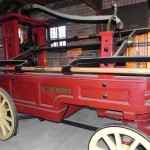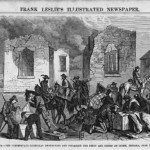These days, traveling from Corydon to Indianapolis is a two hour affair by state road and Interstate highway, but two centuries ago it took a band of pioneers the better part of two weeks.
The occasion for the arduous trip was the transfer of the state capital to Indianapolis in 1824. First-person accounts of the autumn journey survive from the state treasurer, who led the caravan, and his sister-in-law. When he was elected to government office, Vevey lawyer Samuel Merrill was charged with the task of transporting the state’s funds and property from the state’s first capital in Corydon.
A Mr. Seybert, the owner of a team of horses—“none stronger in Indiana”—was hired to drive a covered wagon carrying Merrill, his wife Lydia Jane and their three children, along with his wife’s siblings William and Mary Catherine Anderson. The latter provided her own memoir of the journey sixty four years later.
After a propitiously sunny first day, the rest of the trip was rainy, according to Mary Catherine’s account. She recalls roads alternately “laid with rails or logs for miles” or flooded with seemingly “bottomless” water in other places. Both chronicles record days when progress would be limited to two miles because of obstacles. Mary Catherine walked much of the way alongside the wagon because riding made her sick. The “jolting” also upset her niece, whom she carried part of the way.
Three other children rode in a second wagon, carrying the family of State Printer John Douglass. Their cow, tied to the back of the wagon, also made the one hundred sixty mile journey.
Public property to be moved included the state’s printing press, packed into a wooden strong box. Another crate contained the state’s treasury in silver. “Whether there was much money in it,” Mary Catherine recalls, “I cannot say; but I think not much.” Nonetheless, Merrill and Douglass slept beside the boxes “in the wagons or on the ground” to protect their contents.
The men sought lodging for their families in homes along the way, varying from a “good looking frame house” to “a room without lathing or plastering” to a rude one-room dwelling. Both accounts note the presence at one wayside home of a young courting couple, gazing silently at one another beside the hearth. The accounts are consistent in the detail of the young man’s coon-skin cap, with tail attached, convincing the children he was a bear.
Arriving in Indianapolis, Mary Catherine recalls having been embarrassed by the driver’s insistence on stringing his horses with bells on entering the city. “I was glad to be in a covered wagon at that time,” she notes. The Merrill family’s first home in the city was a two-room cottage on West Washington Street.
Within two years, Mary Catherine married Isaac Naylor, a veteran of the Battle of Tippecanoe, with whom she moved to Crawfordsville in 1833.
Topic selection and research for this essay was provided by the Indiana Magazine of History.
IMH Source Article: Mary Catherine Naylor’s Account of the Removal of the State Capital to Indianapolis, Indiana Magazine of History, vol. 27, no. 3, September 1931, pp. 240-243.





















